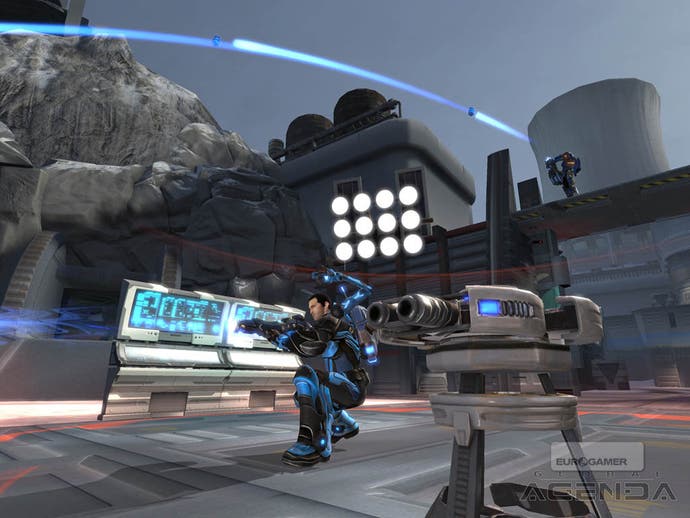Global Agenda
The MMO that isn't.
You can't launch a rocket in a first-person shooter these days without clipping an MMO influence - whether it's Call of Duty 4's world-conquering perks and persistent stats, the elaborate intra-team relationships within Team Fortress 2, or Battlefield Heroes' reliance on microtransactions - but developers heading in the other direction are fewer and further between.
Hi-Rez Studios, with its mixed background in shooters, strategy games and MMOs, is an exception. In fact, on the surface of it Global Agenda resembles an MMO with its feet merely dangling in an action pond. You level up your character by grinding player-versus-environment missions for resources that can be crafted into stat-boosting implants, and combat delivers experience points that go toward improved skills, all of which benefits your Agency (guild) in a hex-based metagame that sees you fighting for territory in "seasons" of gameplay that last just over a month. It floats along on Unreal Engine 3, leaving Tribes-shaped ripples in its wake, but it's treading water on the shoulders of goblins and will charge a monthly subscription.
Except a brief hands-on at Penny Arcade Expo last month suggests it's a lot closer to games like Team Fortress 2 when it comes to player-versus-player combat. Thrown into a "ticket game", where two teams of eight compete for ownership of three control points, it's very much a team-based shooter, albeit a third-person one rather than first.
I get to play as an Assault class, equipped with a rocket launcher, a shotgun and an axe. Controls are FPS staples, apart from a few number-key stabs to employ rechargeables - an EMP grenade and a pair of shields for blocking area-of-effect and other attacks for a few seconds each. Every class has a wicked jetpack, too, easily controlled with a jump and a bit of mouse-button mashing, which allows players to take advantage of the maps' impressive verticality.

There are four classes in all - the others are Recon (stealth), Medic (healing, wouldn't you know) and Robotics (engineer) - and the nature of the interplay is comparable to TF2. The Assault class works well either as a Tank or a Destroyer, stomping around doing lots of area-of-effect damage to people defending control points, and had I not been thrown in at the deep end while simultaneously trying to interview game designer Andy Harmon, I'm told I would have been striking up good relationships with a nearby Medic, whose speciality is a healing gun, or perhaps Recon players, whose stealth speciality allows them to infiltrate objectives while my bruising Assault character draws the enemy's attention.
"There's an interplay of rock-paper-scissors to it," says Harmon, sporting an impressive moustache, "but it's not class-based, because sometimes we've done some so that just as often as there's a counter to another class, there's a counter within your class - so a Robotics can be one of the most effective Robotics-killers, and Assault Tank and Assault Destroyer face off against each other very well."
The Assault class' speciality today is a rocket launcher, but there will be other weapon options, and you can reconsider your loadout in respawn areas. Frankly, I wish I'd chosen a different class, but it's a bit late now. I'm interested in the Robotics' setting up spawn points for their team inside control areas, or up on balconies where they can attack from above, drawing jetpacking defenders away to deal with the problem. As it is, I do reasonably well once I start reaching for shields while under attack and get a grip on the melee system, which allows you to attack with one mouse button and block with the other - absorbing a small amount of damage but also deflecting some of it back if you can time it well enough.


